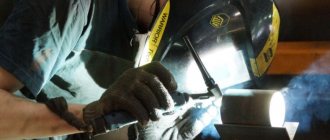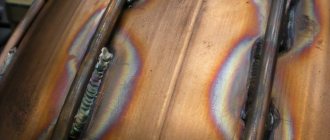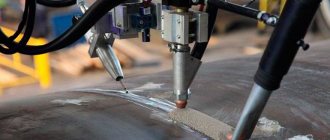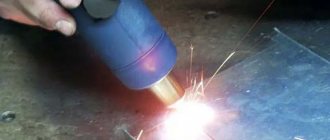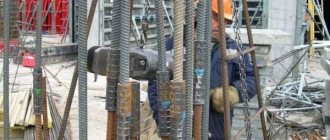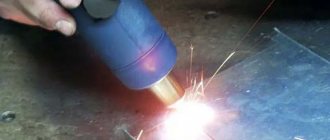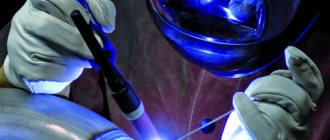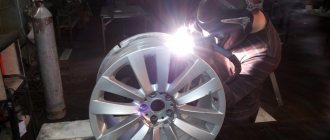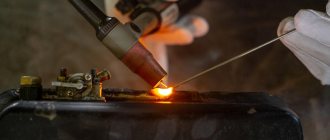Argon welding is a common technology that is most often used when it is necessary to join parts made of aluminum and its alloys. Argon arc welding is the optimal technology when it is necessary to join aluminum parts, since this gas effectively protects the weld pool, as well as the molten filler material, from the negative effects of oxygen contained in the surrounding air.
Argon welding process
Advantages and disadvantages of technology
As any welding specialist knows, welding aluminum is very problematic precisely because on the surface of this metal, when it comes into contact with oxygen, an oxide film is formed, which has a significant melting point. Argon arc welding makes it possible to effectively protect the surface of the parts being joined, as well as the weld pool, from the negative effects of oxygen. Argon, due to its characteristics, completely displaces oxygen from the welding zone, which is why this process proceeds as efficiently as possible.
Welding seam made in a protective argon environment
Welding in an argon environment is successfully used not only when working with parts made of aluminum, but also with products made of other metals: cast iron, stainless steel, titanium, copper, silver, gold, etc. The main reasons why welding using this technology is very popular , are the following:
- high quality of formed welded joints, the seams of which are free of pores and foreign impurities;
- when carrying out such welding, the parts being connected are heated very slightly, which minimizes the risk of their deformation;
- the speed of argon welding, due to the high temperature of the welding arc, is quite high, which makes this technology very effective and economical;
- the seam obtained by argon welding is characterized by a uniform penetration depth;
- Using this technology, you can effectively weld parts made of metals that cannot be joined by other welding methods.
Argon arc welding makes it possible to obtain neat and beautiful welds, which is of great importance in many situations.
Argon-welded connection between a flange and a stainless steel pipe
Among the disadvantages that this technology also has are the following:
- the need to use fairly complex equipment and fine-tune it;
- To perform argon welding, a specialist must have the appropriate skills and experience.
Technological features of welding
The most familiar example of the use of welding performed in an argon environment is the restoration of automobile wheels made of light alloys based on aluminum. In the process of such restoration, the cracks they received during harsh use are welded on the car rims. It is almost impossible to carry out such a procedure using other methods of joining metal, so the technology of argon arc welding in this situation is practically no alternative.
Repair of light alloy car wheels using argon welding
The technology of argon welding involves the use of a non-consumable electrode, which is made of tungsten. This metal is known to have unique characteristics: its melting point is 3410 degrees, its boiling point is 5900 degrees, and even when in a red-hot state, it retains its exceptional hardness. What is important is that when making one meter of weld, only a few hundredths of a gram of tungsten is consumed.
The resistance of non-consumable electrodes made of tungsten becomes even higher if this material is doped with oxides of rare earth metals: cerium, lanthanum, yttrium, thorium, zirconium, etc. The tungsten electrode is located in the center of the ceramic nozzle, through which protective gas.
Parameters of popular foreign-made tungsten electrodes (click to enlarge)
The principle of performing welding work involving the use of a non-consumable electrode and shielding gas is as follows.
- A mass is connected to the parts to be joined, as in conventional arc welding.
- If manual argon arc welding is performed, the welder holds a torch with a non-consumable electrode in his right hand, and the filler material in his left hand, from which the weld is formed.
- When you press a button on the holder, an electric arc is ignited between the tungsten electrode and the surface of the parts to be joined, which ensures the melting of the edges of the parts to be joined and the filler material. Such an arc, in fact, is the main tool used when performing argon welding.
- Unlike the principle of conventional electric welding, joining aluminum parts using a tungsten electrode and a filler rod does not involve the latter performing transverse movements, but only those performed in the longitudinal direction.
The metal used as a filler metal is one whose chemical composition best matches the composition of the material from which the parts to be joined are made. The main purpose of such material is to fill the gap between the parts being connected and, accordingly, to form a weld.
The thermal energy, which is necessary for melting the edges of the parts being connected and the filler material, is generated using an electric arc burning between the electrode and the surface of the parts being connected. The welding zone, into which nitrogen and oxygen cannot be allowed to enter from the ambient air, is protected with argon, which displaces these gases from the working area.
According to the principle of its operation, such welding is a hybrid of electric and arc welding. From electric welding, this welding received an arc that creates thermal energy, and from gas welding, it received the principle of protecting the welding zone, for which the inert gas argon is used.
ARGON ARC WELDING
Argon is a colorless gas, 1.38 times heavier than air; it does not form chemical compounds with most elements and is insoluble in liquid and solid metals. Argon is obtained from air supercooled to low negative temperatures by selective evaporation at temperatures above –185°C,
According to GOST 10157-79, three grades of argon of varying purity are produced: B - 99.99%, I - 99.96%, II - 99.90% (the percentages of pure argon are indicated, the rest is oxygen and nitrogen impurities). Argon is supplied and stored in a compressed gaseous state in steel cylinders under a pressure of 15 MPa.
Argon arc welding can be used to weld products using two schemes: non-consumable and consumable electrodes.
Welding with a non-consumable electrode is used, as a rule, when joining metals with a thickness of 0.1 ... 6 mm; consumable electrode - from 3 or more.
Tungsten rods in accordance with GOST 23949 - 80, grades EVCh, EVL, EVI, are used as a non-consumable electrode. The diameter of the tungsten electrode is selected depending on the value of the welding current (Table 8)
Table 8
| Current strength, A | 20-60 | 60-120 | 120-180 | 180-260 | 260-320 | 320-500 |
| Diameter of tungsten electrode, mm | 1-2 |
Welding with a non-consumable electrode is usually carried out using direct current of straight polarity. For welding Al alloys, direct current of reverse polarity or alternating current using oscillators is used, which makes it possible to destroy oxide films due to the effect of cathode sputtering.
Rice. 37.
To weld non-consumable electrodes in a shielding gas environment, you must have (Fig. 25): 1 – filler rod or wire; 2 – nozzle; 3 – current-carrying mouthpiece; 4 – burner body; 5 – non-consumable tungsten electrode;
6 – burner handle; 7 – protective gas atmosphere; 8 – welding arc; 9 – bath of molten metal.
The arc burns between the tungsten electrode and the workpiece being welded. An filler rod made of a material similar in chemical composition to the base metal is fed into the arc flame zone. The metal rod and the base metal form a pool of molten metal. Welding is carried out with a special torch in which the electrode is fixed; argon is supplied through the torch channel into the arc zone.
With alternating current, the maximum permissible current is I = 60d, I is the current strength, A; d – electrode diameter, mm (Table 7) (type of connection - butt),
When welding on direct current of direct polarity with torches without water cooling, the maximum permissible welding current is determined by the formula:
Isv = 80 d, A (10)
When welding with water cooling, I increase the welding current by 20-30%.
Modes for argon arc welding with a non-consumable electrode
Table 9.
| Metal thickness, mm | Welding current, A | Wire diameter, mm | Gas consumption, l/min | Welding speed, cm/min |
| 1,0 1,5 2,0 | 30 – 40 45 – 70 70 – 120 | 1,6 1,6 2,0 | 3 – 4 4 – 5 5 – 6 | 12 – 28 10 – 20 8 – 18 |
In manual welding, the diameter of the filler rod is determined by the formula:
, mm (11)
where S – metal thickness, mm.
A welding station for manual welding on direct current includes a direct current source, a special torch, a gas cylinder, a reducer, a rotameter for measuring gas flow, etc.
For DC welding, welding generators and welding rectifiers are used as a power source.
Argon welding is used for stainless, heat-resistant steels and aluminum alloys.
When argon arc welding, performed with a non-consumable electrode, a weld is formed in accordance with GOST 14771-76.
Date added: 2016-11-04; ; ORDER A WORK WRITING
Similar articles:
poznayka.org
Welding equipment
One of the most important elements for performing argon welding are torches, the most popular models of which are RGA. Requirements for such torches, selected in accordance with the strength of the welding current and the diameter of the electrodes used, are specified in GOST 5.917-71.
Overall dimensions and technical parameters of burners must comply with the requirements of the standard
The most common models of burners produced in accordance with the requirements of this GOST are RGA-150 and RGA-400. The former can be used with welding currents up to 200A, they have natural cooling, and the diameter of the electrodes with which they can work is in the range of 0.8–3 mm. Torches of the second type, according to GOST requirements, can operate with welding currents up to 500A, they are water-cooled, and the electrodes used with them have a diameter of 4–6 mm. The requirements of this GOST also stipulate the parameters of burners that are made of ceramic materials.
Burners, also called nozzles, can have different shapes: cylindrical, conical, profiled. When performing argon welding indoors, where there is no wind, torches of conical and cylindrical shape and small diameter are used. If welding is performed outdoors, then a profiled or cylindrical nozzle is used, the diameter of the outlet hole of which is increased. There is also an extended type of torch used when argon welding is performed in hard-to-reach places.
Welding carried out in an argon shielding gas environment may differ in different levels of automation of the technological process. Depending on this parameter, argon welding is divided into the following types:
- manual;
- mechanized;
- automated;
- robotic.
Naturally, the equipment used in each specific case, as well as the cost of performing technological operations, will differ.
Multifunctional welding station for industrial use
Each of the above types of work has its own characteristics, which are as follows.
- Manual welding in an argon environment. When performing such welding, moving the torch and feeding the welding wire are carried out manually. The electric arc, due to which the edges of the parts being connected and the filler wire are melted, is created using a non-consumable tungsten electrode.
- Mechanized welding performed in an argon environment. This type of technological process assumes that the welder controls the torch manually, and the filler wire is fed into the welding zone in a mechanized mode.
- When performing automated argon welding, both the supply of filler wire and the movement of the torch are carried out in an automated mode, and the operator controls these processes.
- When using robotic equipment, human participation in the technological process is minimized. All modes of argon welding in this case are controlled by automation.
Operation of mechanized welding carriage
Argon arc welding of stainless steels
These instructions apply to manual and automatic welding in argon of austenitic stainless steels.
In accordance with the requirements of the instructions, it is allowed to weld parts made of stainless steels of type X18N9T with parts made of low-carbon steel and nickel.
The instructions should be used to guide the design, development of technological processes, manufacturing, inspection and acceptance of welded assemblies.
Deviations (tightening or reducing requirements) from these instructions can be included in the technological documentation for the product in agreement with the chief technologist and the customer’s representative.
Materials, equipment, devices, tools are given in the Appendix.
Copper argon arc welding must be carried out by certified welders in compliance with the safety rules set out in the safety instructions.
Allow certified welders who have the right to perform welding work on stainless steels to perform welding work.
Preparing parts for welding
Remove oil and other grease from the parts to be welded by wiping with a cotton cloth moistened with gasoline.
After degreasing, further prepare the parts for welding by chemical etching or mechanical cleaning of the welded edges.
Perform mechanical stripping or etching of welding wire in accordance with the relevant technical specifications.
Mechanically clean the welded parts on both sides to a metallic shine to a width of 15-20 mm using a steel brush or scraper.
Note - Burrs, cracks, and delaminations are not allowed on the edges of parts prepared for welding.
After mechanical cleaning, wipe the edges of the parts with a cotton cloth moistened with gasoline.
Perform chemical etching of stainless steel parts in accordance with the relevant technical specifications.
Anneal thin-sheet parts in a vacuum oven at a temperature of 900-950 °C for 20-30 minutes. Working vacuum 5×10-4 mm Hg.
Use parts and welding wire prepared in accordance with these instructions for welding no later than 72 hours.
Welding
Select the collet, nozzle and tungsten electrode of the torch based on the ratios indicated in Table 1.
Table 1
| Diameter of tungsten electrode, mm | 1,5-2 | 2,5-3 | 3,5-4 | 4,5-6 |
| Nozzle outlet diameter, mm | 5-7 | 7-9 | 9-12 | 12-14 |
| Argon consumption, l/min | 2-3 | 4-5 | 6-8 | 10-18 |
Note - Using the recommended ratios allows for good protection of the weld area from environmental influences.
Wipe the collet, nozzle and tungsten electrode of the torch with a cotton cloth moistened with alcohol. Wipe down every time before starting a shift.
Install a multilayer mesh with a hole for the tungsten electrode between the collet and the torch nozzle.
Fix the tungsten electrode in the burner so that its protrusion from the burner nozzle does not exceed 5-12 mm.
Perform operations before starting the shift.
Check the appearance of the welding installation, make sure that there are no foreign objects and that the installation is grounded.
Supply the installation with supply voltage from the power distribution board.
Open the valve of the argon cylinder. Using the reducer, set the gas flow rate using the rotameter according to Table 2.
Weld using direct current of straight polarity.
Assemble parts or assembly units for welding using a jig and tack welded edges at diametrically opposite points using the mode according to Table 2.
Remove the jig from the assembly after tacking and install it in the welding fixture.
Welding is carried out in the recommended mode according to Table 2.
Note - If the weld seam of the assembly is closed, overlap it along the length by 10-20% of the perimeter of the seam.
Upon completion of welding, remove the welded assembly from the fixture.
Inspect the assembly using a magnifying glass for defects in the weld. The seams must have a smooth or finely flaky surface without visible defects: lack of fusion, undercuts, pores, cracks, unfilled craters.
Note - Oxidation of the main zone (tarnish color) is not a rejection sign.
At the end of the work shift, turn off the unit and close the cylinder reducer valve.
Cleaning of the weld seam in order to identify scale, splashes and influxes of metal should be carried out according to the route map for the manufacture of the unit.
The grades of steel welding wire (filler material), depending on the grades of steel of the parts being welded, are indicated in Table 3.
Table 2 - Approximate welding modes for stainless steels Thickness, mm Welding mode Argon consumption l/min Welding current, A Arc voltage, V Welding speed, m/hour Tungsten electrode diameter, mm Filler wire diameter, mm In the arc zone to protect the seam For blowing
| Automatic welding, tungsten electrode without additive | |||||||
| 0,8 | 60-100 | 9-10 | 30-50 | 2,0 | — | 6-8 | 1-2 |
| 1,0 | 70-100 | 9-10 | 25-40 | 2,0 | — | 6-8 | 1-2 |
| 1,5 | 100-160 | 10-12 | 20-35 | 3,0 | — | 9-10 | 2-3 |
| 2,0 | 160-180 | 12-13 | 20-30 | 3,0 | — | 10-12 | 2-3 |
| 2,5 | 180-200 | 12-15 | 20-30 | 3,0 | — | 10-12 | 3-4 |
| 3,0 | 200-220 | 12-15 | 20-30 | 4,0 | — | 12-14 | 3-4 |
| Automatic welding, tungsten electrode using additives | |||||||
| 1,0 | 70-120 | 9-10 | 20-25 | 2,0 | 0,5-0,8 | 6-8 | 1-2 |
| 1,2 | 70-120 | 9-10 | 20-25 | 2,0 | 0,8-1,2 | 6-8 | 1-2 |
| 1,5 | 120-150 | 10-12 | 20-25 | 3,0 | 1,2-1,6 | 9-10 | 2-3 |
| 2,0 | 170-200 | 10-12 | 20-25 | 3,0 | 1,2-1,6 | 9-10 | 2-3 |
| 2,5 | 180-210 | 12-15 | up to 20 | 4,0 | 1,6-2,0 | 10-12 | 3-4 |
| 3,0 | 200-240 | 12-15 | up to 20 | 4,0 | 1,6-2,0 | 10-12 | 3-4 |
| Manual tungsten welding | |||||||
| 1,0 | 45-65 | — | — | 2,0 | 1,2-1,6 | 5-8 | 1-2 |
| 1,5 | 45-70 | — | — | 2,0 | 1,2-1,6 | 5-8 | 1-2 |
| 2,0 | 70-90 | — | — | 2,0 | 2,0 | 8-10 | 2-3 |
| 2,5 | 80-100 | — | — | 3,0 | 2,0-2,5 | 10-12 | 2-3 |
| 3,0 | 100-130 | — | — | 3,0 | 2,0-2,5 | 10-12 | 2-3 |
Table 3 - Selection of welding wire grade depending on the grade of steel being welded Grade of steel of welded parts Grade of steel welding wire GOST 2246-70
| 12Х18Н9 | Sv-04Х19Н9 |
| 12Х18Н9Т | Sv-06Х19Н9Т |
| 12Х18Н10Т | Sv-07Х19Н10Б |
Welding quality control
Carry out continuous quality control of welds after completion of welding using a magnifying glass in accordance with the drawing.
Inspect the welds along the entire length on both sides.
Carry out grading of defective welds in accordance with the requirements of Table 4.
It is allowed to weld defective areas of welds no more than twice.
Completely reject welded assemblies that have defects in the welds, the dimensions of which are larger than those allowed for correction.
Table 4 - Sorting of seam defects based on the results of visual inspection Name of defects Number and size of defects per 100 mm of seam Allowed to be left without correction Allowed for correction
| Displacement of the edges of the parts being welded | Up to 0.1δ along the entire length of the seam | More than 0.1δ along the entire length of the seam |
| Lack of penetration | Not allowed | Any length |
| Cracks | Not allowed | Total length up to 15 mm |
| Burn-through | Not allowed | No more than 1 |
| Undercuts | Depth up to 0.1δ | Depth more than 0.1δ |
| Sinks | Depth up to 0.2δ | Depth more than 0.2δ |
| With a diameter of up to 0.5δ - no more than 2 pieces | With a diameter of up to 0.5δ - no more than 5 pieces | |
| Pores and tungsten inclusions | Diameter up to 0.4δ - no more than 3 pieces | With a diameter of more than 0.4δ - up to 0.1δ no more than 6 pieces |
| Accumulations of small pores and tungsten inclusions | Total area up to 5 mm2 | Total area up to 15 mm2 |
| Penetrations that do not present porous sagging and do not interfere with further assembly | 100 % |
Note - When measuring defects in welds, it is necessary to use a tool: a caliper, a probe, special templates, or others.
Materials
- Lanthanated tungsten in the form of rods with lanthanum content (1.3-1.8)% TU 48-19-27-88.
- Argon gas, highest grade GOST 10157-79.
- Steel welding wire GOST 2246-70.
- Cotton fabric of calico group GOST 29298-92.
- Knitted gloves GOST 5007-87.
- Gasoline "Galosh" TU 38-401-67-108-92.
- Technical ethyl alcohol GOST 17299-78.
- High purity argon type “HF” TU 6-21-12-94 (for stainless steel parts with a thickness of 0.15-0.8 mm).
Equipment, devices and tools
- Power source type PS-300, PS-300M, PSO-500, VKSM-1000, UDG-3010 UZHLU or UDG-101 for shielded gas welding with a set of welding torches, collets and nozzles.
- Rheostat type RB-200 or RB-300.
- Balloon reducer TU 26-05-90-87.
- Rotameter type RM-11 or RM-1 GOST 13045-81.
- Pressure gauge DM 60-0.2 MPa-4 GOST 2405-88.
- A set of technical rubber tubes GOST 5496-78 (for supplying protective gases and water to the burner).
- Protective welding helmet with a set of protective welding glasses ES-100, ES-300, ES-500 TU 38.11.0208-86.
- Sealed protective glasses GOST 12.4.001-80.
- Steel brushes made of stainless wire with a diameter of (0.2-0.3) mm GOST 18143-72.
- Assembly and welding devices.
- Magnifying glass LP-1-5 GOST 25706-83.
- Calipers GOST 166-89.
- Metal ruler GOST 427-75.
- Device for laminar gas flow for the burner.
weldworld.ru
Equipment Features
The equipment used to perform welding in an argon shielding gas environment is divided into several main categories:
- special type equipment;
- universal;
- for specialized purposes.
The most popular equipment, both in production and at home, is universal type equipment, which allows you to use all kinds of argon welding modes and perform high-quality connections of various types of parts.
Homemade welding table
The so-called welding station, at which gas-shielded welding is carried out using a non-consumable electrode, must be equipped with the following main and auxiliary equipment:
- source of direct or alternating current;
- a set of burners that are used when working with currents of different types;
- a special device called an oscillator, which ensures rapid ignition of the welding arc and its maintenance in a stable state;
- equipment that is responsible for controlling the welding process, as well as for the safety of the welder and the protection of the welding machine;
- devices that ensure stability of welding current parameters.
Recently, innovative argon welding techniques have been increasingly used. Such techniques, naturally, require the use of additional equipment, which allows not only to increase the efficiency of the welding process, but also to significantly improve the quality of the formed joint. Such technologies, in addition, make it possible to weld parts of significant thickness.
One of these techniques, which has recently become increasingly popular, is welding using pulsating current. At the moment when a current pulse enters the welding zone, the edges of the parts being joined and the filler material melt, and in the pauses between such pulses they crystallize. Using an automated welding machine control system, such pulses are synchronized with the movement of the welding arc, which ensures the formation of a high-quality connection. In addition, exposing the parts to be joined to short pulses of welding current eliminates the risk of overheating and, as a consequence, subsequent warping.
Among the modern equipment used for welding in a shielding gas environment, it is worth noting models that implement the function of heating the filler wire before feeding it into the welding zone. This option allows you to obtain high-quality and reliable welded joints.
Welding with hot filler wire (TIG Hot-Wire)
On the modern market you can also purchase models of devices whose welding work is performed using several non-consumable electrodes. This improvement allows not only to perform argon welding at high speed, but also to obtain high-quality welded joints. In order to implement these and many other options in equipment for argon welding, it is enough to equip it with additional blocks and attachments.
But, of course, the most common device successfully used for welding in argon is an inverter. Such a universal device, which can be equally successfully used both in industrial conditions and at home, allows even welders who are not highly qualified and have extensive experience to make high-quality welded joints. A significant advantage of using such devices is that they are quite easy to learn and do not cause great difficulties in operation and maintenance.
All about manual welding: types, capabilities and applications
Metal welding is the technological process of creating a permanent connection of parts through the formation of a strong interatomic bond. The emergence of such a stable connection can occur as a result of various physical processes. These processes form three main classes of welding, in accordance with GOST 19521-74:
- thermal (fusion welding without applying pressure)
- thermomechanical (melting with the application of pressure)
- pressure.
Currently, there are many types of welding. Their number is constantly growing. Types of welding are divided according to the following technical characteristics:
- according to process continuity
- according to the method and nature of metal protection in the welding zone
- by type of shielding gas
- by degree of mechanization
Based on the type of mechanization, welding is divided into:
- automatic
- automated
- mechanized
- manual.
The development of automated welding methods has led to a significant increase in the speed and quality of the process. At the same time, manual welding has its advantages, which make it indispensable in a number of cases:
- possibility of use in hard-to-reach places;
- accessibility for work in various spatial positions;
- speed of transition from one welded material to another;
- a wide selection of electrode grades, allowing welding of various types of steel;
- ease of transportation and ease of maintenance of welding equipment.
With the help of manual welding, numerous problems are solved in construction, production, service sector and everyday life.
Manual electric arc welding of metal can be performed using two types of electrodes. Electrodes are special rods with a protective coating made from welding wire. The most common technology is welding with consumable electrodes. The edges of the electrode and the workpiece, in contact, form an electric arc, which melts the metal, forming a weld pool. When the metal of the electrode and the workpiece are mixed, a weld is formed. Molten slag rises to the surface. Final processing during subsequent hardening is necessary for working with seams covered with slag.
Spatial position, size and shape of the edges of the surfaces being welded, speed of arc movement - these factors influence the dimensions of the weld pool. The gradual melting of the electrode forces the welder to make a smooth downward movement to maintain arc length. Movement along the axis of the seam is necessary to fill the groove. The width of the seam is formed due to the transverse movement of the hand.
The position of the seams in space is divided into lower (up to 60º), vertical (60-120º) and ceiling (120-180º). The easiest position to work with is the bottom position of the seam. Retention of the weld pool is necessary to avoid lack of penetration and burn-through during arc welding. This is achieved by using a lining (removable copper or non-removable steel) and applying an additional weld.
The vertical position makes it difficult to form a seam due to the flow of molten metal. In this case, welding productivity decreases. Creating horizontal seams becomes especially labor-intensive.
To perform high-quality welding in the ceiling position, it is necessary to reduce the size of the weld pool as much as possible. This is achieved by using small diameter electrodes, reducing the current strength and creating short circuits.
Manual arc welding technology using consumable electrodes is more productive, but requires the removal of slag that forms on top of the seam as the work progresses.
Manual argon arc welding uses a non-consumable electrode. The welder holds an argon torch in one hand and a filler wire in the other. The burner is a cylindrical handle, inside of which a tungsten electrode is attached using a special holder. Shielding gas is supplied to the workpiece being welded through the nozzle. Argon is an inert element; it displaces air from the welding zone and prevents the chemical reaction of the molten metal.
The arc is created in a non-contact manner. For this, a special device called an oscillator is used. The purpose of the oscillator is to create high-voltage, high-frequency pulses. Under the influence of pulses, the arc gap is ionized and the arc is ignited. Manual argon arc welding technology requires a more highly qualified welder. At the same time, the number of types of materials being welded and the quality of the seams are much higher than that of electric arc welding done by hand. Electrodes coated with contaminants make it impossible to carry out high-quality arc welding. The cleanliness of the electrode edge is compromised upon contact with the metal being welded.
Semi-automatic welding is a type of manual welding. The electrode (welding wire) is supplied automatically. The manual process involves moving the arc along the welding line. Semi-automatic welding is characterized by the least labor intensity and high productivity. Mainly used for welding stainless, low alloy and low carbon steels.
The main application of resistance welding occurs on an industrial scale. DIY spot welding is the only type of resistance welding available at home. The process technology involves placing the parts to be welded between the electrodes. Then the surface is heated due to the passage of welding current, and subsequent plastic deformation occurs. Manual spot welding is characterized by high efficiency and strength of the resulting seams.
A homemade welding machine for spot welding can be made at home on your own. The desktop version is used most often. Main components: welding transformer, semiconductor thyristor and time relay. Electrodes are made mainly of copper with an admixture of chromium and zinc. Less commonly used are welding rods based on bronze and tungsten. The diameter of the connection points should be 2-3 times greater than the thickness of the connection part. They do resistance welding with their own hands when repairing household appliances and kitchen appliances.
GAS WELDING
Another type of welding work. Gas welding technology consists of gas-flame processing of metal with a special torch. The flammable gas for gas welding is acetylene. Less commonly used are hydrogen, methane, propane, and kerosene vapor. Combustion occurs in oxygen vapor to effectively achieve high temperatures.
Particular importance when gas welding is given to compliance with fire safety rules. All types of flammable gases are explosive. Detonation can be caused by exceeding the permissible pressure and rapid heating to a temperature of 500ºC.
The main tool in the work of a gas welder is a torch. It serves to form a flammable mixture of acetylene and oxygen. Gas burners are of injection and non-injector types. Welding torches are equipped with replaceable tips for working with parts of different thicknesses.
Gas welding is used in the processing of alloy and carbon steel, cast iron and non-ferrous metals. Defects in castings, chips, and cracks in pipes are corrected using manual gas welding.
Welding processes, equipment used, safety precautions, control and quality are strictly regulated by GOSTs. Here are some of them:
GOST R ISO 17659-2009 defines multilingual terms for welding joints
GOST 5264-80 and GOST 11534-75 are developed for manual arc welding
GOST 14771-76 and GOST 23518-79 establish the basic requirements for gas-shielded arc welding
GOST 10157-79 regulates technical conditions for Argon
GOST 5583-78 provides technical conditions for Oxygen.
Similar articles
goodsvarka.ru
Do-it-yourself welding work
To always be able to perform argon welding, in addition to the welding machine itself - an inverter or transformer device, you will need:
- burners in which a tungsten electrode will be installed;
- a cylinder containing the protective gas;
- valves and reducers, with the help of which the supply of protective gas will be regulated;
- protective equipment: special mask, gloves, etc.
Welder protective mask with automatic light filter
Before performing argon welding, the surfaces of the parts to be joined should be thoroughly cleaned of dirt, oil, grease stains, and oxide film: in the case when it is necessary to weld parts made of aluminum and alloys based on this metal. To carry out this cleaning, organic solvents are used, and the oxide film is removed using a metal brush or a grinding machine.
Before igniting the welding arc, it is necessary to turn on the supply of shielding gas, which is done 7-10 seconds before the start of the process. Also, after finishing welding, you need to wait a few seconds (5–7) and only then turn off the gas supply.
When performing argon welding, the non-consumable electrode is located as close as possible to the surface of the parts being joined, which ensures high stability of the electric arc and high-quality penetration of the edges of the parts being joined.
As mentioned above, the filler wire does not move transversely; it moves only along the future weld. What is important is that the filler wire is moved ahead of the torch.
In order for the crater of the formed weld to be highly reliable, it is welded at a reduced current strength, for which a rheostat is used.
Welding current regulator
When performing argon welding, it is extremely important to ensure that the electrode and filler wire do not extend beyond the shielding gas zone. If you neglect this requirement, you may end up with a poor quality weld.
Economic benefits of doing your own welding
Argon welding services today are provided by many companies and private craftsmen. The cost of such services, which can hardly be called cheap, depends on the volume and complexity of the upcoming welding operations, the equipment used, and the qualifications of the specialist.
If you have a constant need for argon welding, then you can seriously save on the cost of professional services if you purchase the appropriate equipment and perform the welding yourself. The correctness of this decision is also evidenced by the fact that you can master the basics of argon welding in a fairly short period of time. But, of course, if you rarely need to perform such welding, then it is better to use the services of specialists who have at their disposal everything necessary to quickly and efficiently carry out such a technological process.
And, finally, an interesting video about the nuances of argon arc welding of various metals and the features of its application in practice.
